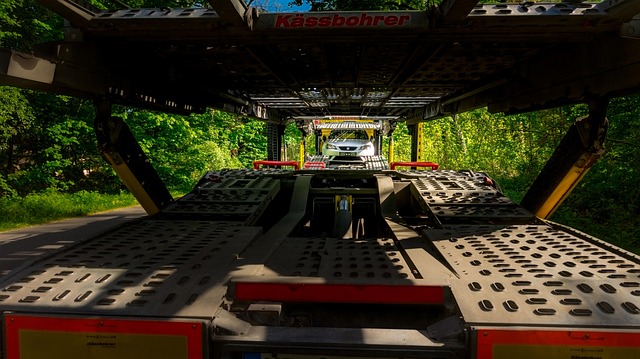Looking to register your car in California? This comprehensive guide walks you through every step, from understanding key requirements to paying registration fees. We cover essential documents, whether you visit the DMV in person or utilize online services, and highlight the crucial role of a DMV VIN verifier in ensuring a smooth process. Get ready to hit the road legally!
- Understand California Car Registration Requirements
- Gather Necessary Documents for Vehicle Registration
- Visit the DMV or Use Online Services for Registration
- Verify VIN and Complete the Registration Process
- Pay Registration Fees and Receive Your License Plate
Understand California Car Registration Requirements

Before registering your car in California, it’s crucial to understand the state’s specific requirements. The California Department of Motor Vehicles (DMV) enforces stringent rules to ensure road safety and vehicle legitimacy. One key aspect is verifying the Vehicle Identification Number (VIN), a unique code that identifies your car’s make, model, and year. This process is typically handled by a certified VIN verifier, who checks the vehicle’s history for any discrepancies or theft issues using the DMV’s database.
In California, it’s mandatory to obtain a mobile vin verification or mobile vin inspection before registration. A mobile vin verifier can conveniently perform this check on-site, ensuring your car meets all legal standards. This step is essential as it protects both you and the state from potential fraud, and helps maintain the integrity of California’s vehicle registry system.
Gather Necessary Documents for Vehicle Registration

Before you start the registration process, make sure you have all the essential documents ready. The California Department of Motor Vehicles (DMV) requires a variety of paperwork to ensure a smooth and legitimate vehicle registration. One crucial document is the Vehicle Identification Number (VIN) verifier, which can be obtained through a mobile vin inspection or by visiting a DMV office for a formal vin inspection.
This VIN number acts as a unique identifier for your car and is essential for several steps in the registration process. Other necessary documents include proof of insurance, a valid driver’s license, and the vehicle’s title (if applicable). Additionally, you’ll need to provide proof of residency, such as a utility bill or lease agreement, and perhaps pay a registration fee, depending on your vehicle’s classification.
Visit the DMV or Use Online Services for Registration

You have two convenient options when it comes to registering your car in California: visit a DMV office or utilize online services. If you prefer face-to-face interaction, heading down to your nearest Department of Motor Vehicles (DMV) office is still an option. There, knowledgeable staff can assist with the registration process and handle any necessary paperwork.
On the other hand, for a more modern approach, California’s DMV offers online registration through their website. This includes a useful feature like a DMV VIN verifier, which allows you to confirm vehicle identification number (VIN) information digitally. Plus, many tasks can be completed from the comfort of your home, including submitting documents and paying fees, making it easier than ever before to register your vehicle. Even more convenient is the option for mobile vin inspection or mobile vin verification services, which come straight to you.
Verify VIN and Complete the Registration Process

After verifying your vehicle’s identity with a valid title and proof of insurance, it’s time to move on to the next crucial step: registering your car in California through the Department of Motor Vehicles (DMV). Start by obtaining a Vehicle Identification Number (VIN) verifier from the DMV or using a reliable mobile vin inspection service. This tool ensures that your VIN is accurate and matches the vehicle you intend to register.
Inputting the correct VIN into the registration system is essential, as it allows the DMV to run a comprehensive check on the vehicle’s history. Once you’ve confirmed the VIN’s authenticity, complete the registration process by gathering all necessary documents, including your driver’s license, proof of residency, and any additional forms required for your specific situation. This may involve paying the registration fee and scheduling an appointment at a local DMV office for a vehicle inspection.
Pay Registration Fees and Receive Your License Plate

After submitting your registration application at the California DMV or via their online portal, the next step is to pay the required fees. These include the vehicle registration fee and a validation fee for each year of coverage. The amount will vary depending on your vehicle’s make, model, age, and fuel type. Once your payment is processed, you’ll be issued a registration certificate, which serves as proof of ownership and allows you to legally operate your vehicle on California roads.
Before receiving your license plates, you must obtain a Vehicle Identification Number (VIN) inspection. This can be done at an authorized location or, for added convenience, opt for a mobile VIN inspection service that comes to your location. The inspection verifies the accuracy of the VIN data, which is crucial information linked to your vehicle’s history and identity, ensuring it matches the records on file at the DMV (DMV vin verifier). With this step completed, you’ll be ready to display your new license plates on your car.
Registering a car in California involves understanding key requirements, gathering essential documents, and completing a straightforward process through the DMV or online services. Always verify your vehicle’s VIN using a trusted dmv vin verifier to ensure accuracy. Once approved, pay the registration fees and receive your official license plate, ensuring your vehicle is legal to drive on California roads.
